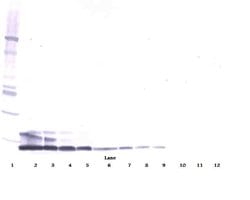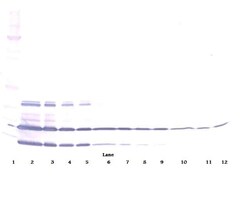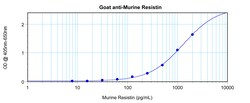Learn More
Invitrogen™ Resistin Polyclonal Antibody, PeproTech®, Invitrogen™
Goat Polyclonal Antibody
Supplier: Invitrogen™ 500P182G100UG

Description
AA Sequence of recombinant protein: SSMPLCPIDE AIDKKIKQDF NSLFPNAIKN IGLNCWTVSS RGKLASCPEG TAVLSCSCGS ACGSWDIREE KVCHCQCARI DWTAARCCKL QVAS. Preparation: Produced from sera of goats immunized with highly pure Recombinant Murine Resistin. Anti-Murine Resistin-specific antibody was purified by affinity chromatography employing an immobilized Murine Resistin matrix. Sandwich ELISA: To detect Murine Resistin by sandwich ELISA (using 100 μL/well antibody solution) a concentration of 0.5-2.0 μg/mL of this antibody is required. This antigen affinity purified antibody, in conjunction with PeproTech Biotinylated Anti-Murine Resistin (500-P182GBt) as a detection antibody, allows the detection of at least 0.2-0.4 ng/well of Recombinant Murine Resistin. Western Blot: To detect Murine Resistin by Western Blot analysis this antibody can be used at a concentration of 0.1-0.2 μg/mL. Used in conjunction with compatible secondary reagents the detection limit for Recombinant Murine Resistin is 1.5-3.0 ng/lane, under either reducing or non-reducing conditions.
Adipose tissue is an energy reserve in animals and is strictly regulated. Adipose cells produce and secrete numerous physiologically important proteins, such as lipoprotein lipase (LPL), leptin, adipocyte complement related protein of 30 kDa (Acrp30), perilipin, and resistin. Resistin, also known as Adipocyte Secreted Factor (ADSF) and FIZZ3, is a cytokine that is specifically secreted by adipocytes. While the function of resistin is not well understood, it appears to have key paracrine roles and has a suggested role in type 2 diabetes. Studies show that in obese, diabetic mice the levels of serum resistin are increased, which has an antagonistic effect on insulin. Additional studies have shown that resistin causes insulin resistance and glucose intolerance in mice. Resistin gene expression requires C/EBP alpha, which is necessary and sufficient for expression. Studies show that the coactivators CBP and p300, which have been shown to display histone acetyltransferase (HAT) activity, abundantly acetylate the histones at the resistin promoter suggesting their role in activating chromatin for resistin transcription. Numerous PPAR gamma and RXR ligands have been shown to downregulate resistin expression in adipocytes.
Specifications
| Resistin | |
| Polyclonal | |
| Unconjugated | |
| RETN | |
| Adipose tissue specific secretory factor; adipose tissue-specific secretory factor; Adipose-specific cysteine-rich secreted protein A12-alpha; ADSF; C/EBP epsilon regulated myeloid specific secreted cysteine rich protein precursor 1; C/EBP-epsilon regulated myeloid-specific secreted cysteine-rich protein precursor 1; c/EBP-epsilon-regulated myeloid-specific secreted cysteine-rich protein; cysteine-r; Cysteine-rich secreted protein A12-alpha-like 2; cysteine-rich secreted protein FIZZ3; dominant inhibitory adipocyte-specific secretory factor; dri; FIZZ3; found in inflammatory zone 3; HXCP1; MGC126603; MGC126609; Resistin; resistin delta2; RETN; RETN1; RSN; RSTN; UNQ407/PRO1199; XCP1; Xcp4 | |
| Goat | |
| Antigen affinity chromatography | |
| RUO | |
| 57264 | |
| -20°C | |
| Lyophilized |
| ELISA, Western Blot | |
| 0.1-1.0 mg/mL | |
| PBS with no preservative | |
| Q99P87 | |
| RETN | |
| E.coli-derived Recombinant Murine Resistin. | |
| 100 μg | |
| Primary | |
| Mouse | |
| Antibody |
The Fisher Scientific Encompass Program offers items which are not part of our distribution portfolio. These products typically do not have pictures or detailed descriptions. However, we are committed to improving your shopping experience. Please use the form below to provide feedback related to the content on this product.


